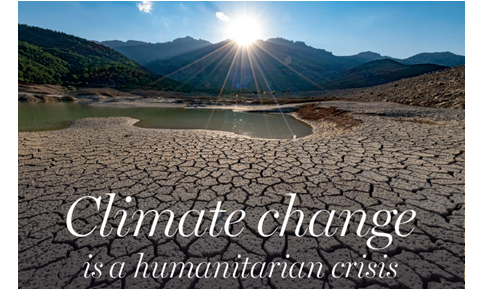
The environment has become Rotary’s seventh area of focus at a time when the world’s infrastructure is crumbling. We see the images of horrendous disasters, such as flooding and drought, but what is the reality? Lucy Carr from the Rotary charity ShelterBox describes life on the front line.
Climate change is creating an unprecedented need for emergency shelter around the world.
Right now, the climate crisis is causing irreversible damage, robbing families of their homes, livelihoods and loved ones and changing lives forever.
Climate change is a humanitarian crisis. At ShelterBox, we see this when we work with communities who have lost everything to tropical storms, flooding and drought – disasters all intensified by our heating climate.
More and more communities are experiencing the consequences of these extreme weather events. 1.7 billion people around the world have been affected by climate and weather-related disasters during the past decade.
The effects of climate change disproportionately affect the poorest communities around the world, as well as increasing the numbers of people living in poverty.
Vulnerable families are on the front line, often forced to leave their homes to survive – either because disasters are becoming more severe, or to find food, water or to make a living. It is estimated that a staggering 1.2 billion people could be displaced by the climate crisis by 2050.
Our changing climate is intensifying extreme weather and worsening already complex situations in conflicts and war zones.
Since the 1960s, the Lake Chad Basin has shrunk by about 90%, turning the area to desert.
People living in the region previously relied on the lake for their livelihoods. In one of the hottest places on earth, it is now almost impossible to make a living from the land or the lake, increasing displacement and strengthening the influence in the region of terrorist organisation Boko Haram.
ShelterBox has supported over 11,000 families, mostly in Cameroon, but also in Chad, Nigeria and Niger, who were forced to flee. Sadly, there still remains a huge shortage of emergency shelter for displaced people.
The climate crisis is having a huge impact on people who depend on predictable weather for their livelihoods: those who farm or live a nomadic life are now struggling to feed their families.
ShelterBox has supported these communities, like families in Somaliland who couldn’t grow crops or feed their cattle and sheep. Rural Somali communities rely on livestock for their income and survival but a three-year drought in the country has now killed up to 80% of the region's livestock. For these communities, extreme weather is the biggest threat.
“We used to sell our goats in Hargeisa for a good price,” says Nimo from Somaliland. “We were living happily and could buy basic necessities and even meat. It was a very good life. But over time, things have changed.
“The livestock died, even the ones that are left cannot be sold to the market because they are in poor health. We are struggling with life now.”
ShelterBox also supports families living in vulnerable locations, who are increasingly affected by extreme weather events, and are often ill equipped to withstand their increasing severity.
Climate change is leading to an increasing number of category 4 and 5 storms. The 2020 Atlantic hurricane season broke a series of unwelcome firsts, as the most active on record with 30 named storms and 14 hurricanes.
“We had never seen a cyclone like that on Pentecost before,” shared John, whose Vanuatu home was destroyed by Cyclone Harold in April 2020.
Like many others caught in the direct pathway of the storm, John was not prepared for its power or severity. “Because we’ve never had a cyclone like that, it meant that we were not ready enough,” he explained.
Adjusting building techniques to cyclone-proof shelters is vital to ensuring safety in the future.
John worked hard to repair his family home, supported with tarpaulins, accompanying aid items and training provided by ShelterBox in partnership with CARE Vanuatu.
He added: “I must make a house, a good house, that if there is a strong wind it can't blow it out.
"So that in the future if another cyclone comes we will be safe there.”
People continue to live in places that they know are at higher risk of hurricanes and floods for a variety of reasons.
For many, it’s their social and cultural ties to an area, homes where their communities have lived for generations.
For others, the opportunities outweigh the risks, and they have no choice but to stay where they can make a living.
Fishing communities want to be close to the sea, but these low-lying coastal areas may be at risk of storm surges. Properties at higher risk are often cheaper.
Those who can’t afford to live in safer areas create homes where they can, even if they will be more vulnerable to disaster.
In 2019 severe flooding in Asunción, Paraguay, forced Mirta and her family from their home.
“I'm tired of always having to move each time there are floods, but we don't have another option. We simply can't afford to buy a home out of the floodaffected areas,” she said.
Most of ShelterBox’s responses have been in areas of the world where communities are already vulnerable and have limited resources to endure the effects of extreme weather events.
ShelterBox provides aid to families reeling from the effects of climate change and, where families are at risk of being displaced several times, we design our aid packages to be mobile and flexible.
Combine that with training – on everything from drainage ditches to divert floods, to bracing and strapping techniques for stronger shelters – and families can better protect themselves for the future.
Climate change is not a tomorrow issue. Together, we can take action to support families on its frontline today.